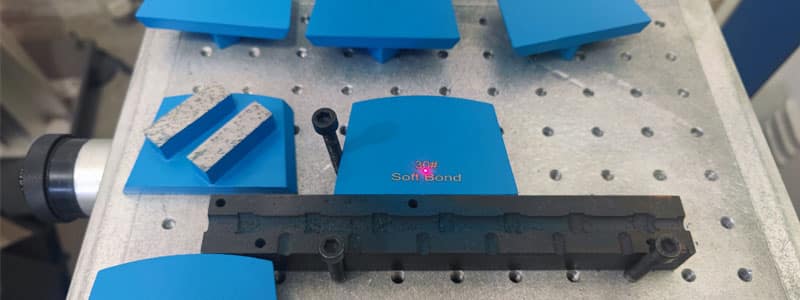
Label engraving is an essential step in making metal bond concrete grinding diamond shoes. It marks the diamond shoes and makes them easily recognizable to users. If you are not a diamond tools manufacturer, it can be hard to understand the details of label engraving. Here, I will point out 3 engraving details to help you better understand the process and make a more informed choice for label engraving next time.
What is Label Engraving?
Label engraving refers to the process of permanently etching text, logos, or designs onto a product’s surface using laser or mechanical engraving techniques. For concrete grinding diamond shoes, label engraving plays a crucial role in enhancing the professional appearance of the product and helping customers quickly identify and manage their tools.
From the engraving short video, we can clearly see the fumes and particulates produced during the engraving process. These are the removed paint layers. To maintain a clean working environment, we use a fan during the process to remove the fumes and particulates generated by laser engraving.
1. What Information to Engrave?
Choosing the right information to engrave can convey very useful details. For diamond grinding shoes, what information should we engrave? Below are some key factors that need to be considered; some are essential, while others are optional. As the available engraving space is usually limited, we suggest engraving the first three pieces of information: Diamond Grit Size, Bond Types, and Brand Logo.
2. Engraving Location: Front or Back?
For the engraving locations, let’s first define the “Front” and “Back.” The front side refers to the segment side, and the back side refers to the connection side, such as the Redi-Lock back of Husqvarna or Scanmaskin grinding shoes. So, where should we engrave the labels: front or back? We had a discussion about this, and both have advantages and disadvantages. Please check the comparison table below:
| Advantage | Disadvantage | |
|---|---|---|
| Front Engraving | Quickly recognize the diamond shoes without having to uninstall them from the floor grinder. | The label may be gradually worn down by grinding debris or particles, making it difficult to recognize by the end of the tool’s life. |
| Back Engraving | Keeps labels protected from abrasion and ensures they remain clean and easy to identify. | You need to remove the diamond shoes from the floor grinder to check the label. |
Our recommendation is that, in most cases, the front is the first choice. Because we have produced so many concrete grinding diamonds, it works well and we have rarely received feedback about label issues. But sometimes, we need to engrave on the back if there is not enough space on the segment side or if our customer requests back engraving. We usually don’t engrave on both front and back, as it is unnecessary and takes much more time.
3. Which Paint Color Works Best for Engraving?
| SERIES | Grey Series | Orange Series | Green Series | Blue Series | Purple Series | Black Series |
|---|---|---|---|---|---|---|
| MOH’S SCALE | 1~2 | 2~3 | 3~5 | 5~7 | 7~8 | 8~9 |
| PSI | Under 1500 | 1500~3000 | 3000~4000 | 4000~5000 | 5000~7000 | Above 7000 |
| MPA | M5~M10 | M10~M20 | M20~M30 | M30~M35 | M35~M50 | M50~M70 |
| CONCRETE HARDNESS | Very Soft | Soft | Medium | Hard | Very Hard | Extremely Hard |
| BOND CODE | VHB | HB | MB | SB | VSB | XSB |
| STANDARD COLOR |
The color has its own temperature, giving different feelings to the tools. The color of diamond grinding shoes not only makes them different in appearance but also serves as an important way to recognize the bond types of the shoes. As an experienced diamond tools manufacturer, Xpert Diamond Tools has established six standard colors to represent six different bond codes, including grey, orange, green, blue, purple, and black. You may notice that we don’t use red. Why? Because after engraving so many shoes, we found that red is the hardest color for label engraving. It takes much more time to complete the engraving compared to other colors.
However, if you need to customize the paint color, we also highly support it, as we understand that product differentiation is very important.
In conclusion, choosing the right engraving details—including the information, location, and paint color—is essential for diamond grinding shoes. Proper label engraving not only helps customers easily identify and manage their tools but also enhances the product’s professional appearance and brand value.